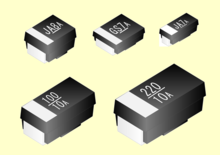
A niobium electrolytic capacitor (historically also Columbium capacitor[1][2]) is an electrolytic capacitor whose anode (+) is made of passivated niobium metal or niobium monoxide, on which an insulating niobium pentoxide layer acts as a dielectric. A solid electrolyte on the surface of the oxide layer serves as the capacitor's cathode (−).
Niobium capacitors are available in SMD packaging and compete with tantalum chip capacitors in certain voltage and capacitance ratings. They are available with a solid manganese dioxide electrolyte.
Like most electrolytic capacitors, niobium capacitors are polarized components. Reverse voltages or ripple currents higher than specified tolerances can destroy the dielectric and thus the capacitor; the resulting short circuit can cause a fire or explosion in larger units.
Niobium capacitors were developed in the United States and the Soviet Union in the 1960s. Since 2002 they have been commercially available in the West, taking advantage of the lower cost and better availability of niobium relative to tantalum.